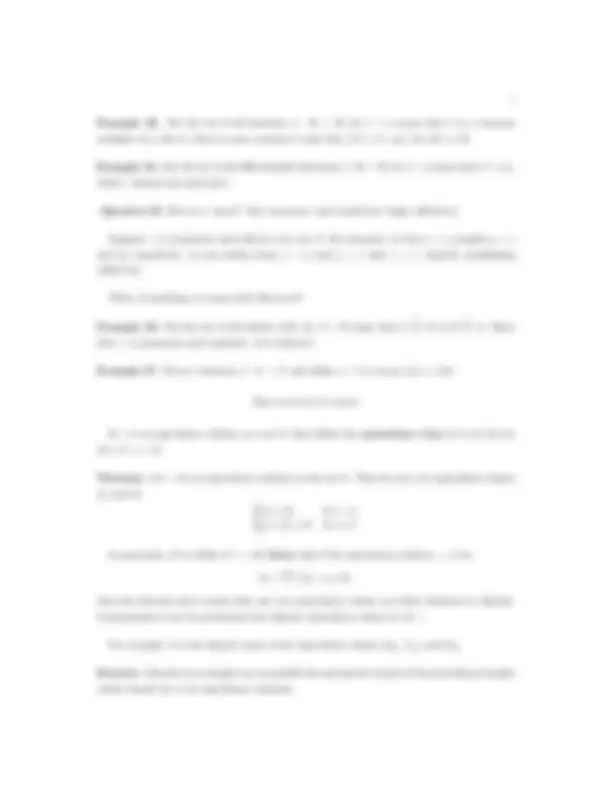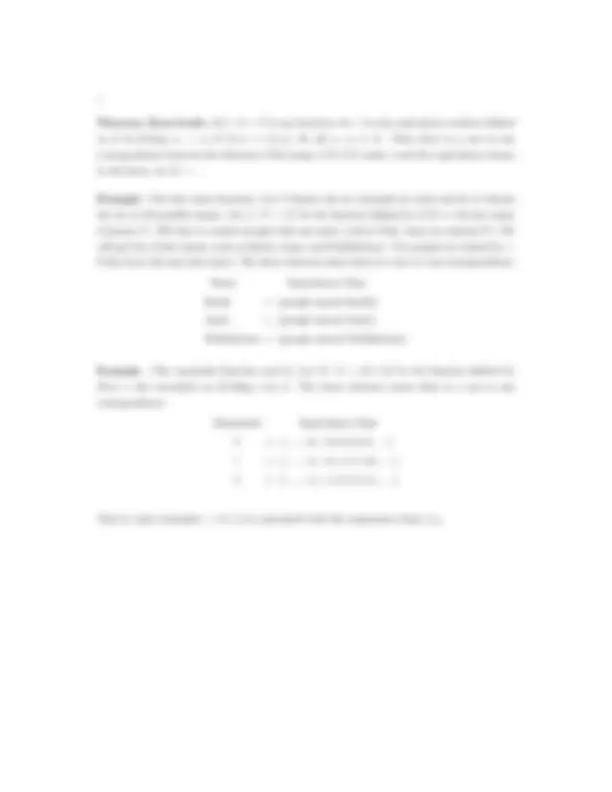




Study with the several resources on Docsity

Earn points by helping other students or get them with a premium plan


Prepare for your exams
Study with the several resources on Docsity

Earn points to download
Earn points by helping other students or get them with a premium plan
Community
Ask the community for help and clear up your study doubts
Discover the best universities in your country according to Docsity users
Free resources
Download our free guides on studying techniques, anxiety management strategies, and thesis advice from Docsity tutors
The concept of equivalence relations and provides numerous examples of reflexive, symmetric, and transitive relations. It also introduces the concept of equivalence classes and their relationship to equivalence relations. Exercises and examples to help illustrate the concepts.
Typology: Study notes
1 / 4

This page cannot be seen from the preview
Don't miss anything!



Equivalence Relations
A relation ∼ on a set S is reflexive if
a ∼ a for all a ∈ S.
A relation ∼ on a set S is symmetric if
a ∼ b implies b ∼ a for all a, b ∈ S.
A relation ∼ on a set S is transitive if
a ∼ b and b ∼ c implies a ∼ c for all a, b, c ∈ S.
A relation ∼ on a set S is an equivalence relation if ∼ is (1) reflexive, (2) symmetric, and (3) transitive.
Example 1. For any set S, a ∼ b means a = b.
Example 2. S = Z, n is a fixed positive integer,
a ∼ b means a ≡ b (mod n).
Example 3. S = R,
x ∼ y means x − y is an integer.
Example 4. Consider the set of all triangles in R^2. For any two triangles T and S in the plane, define T ∼ S to mean that T is congruent to S in the usual geometric sense.
Which of the following are equivalence relations? If not an equivalence relation, which of the three axioms (reflexivity, symmetry, transitivity) hold?
Example 5. In the set Z+, let x ∼ y mean x divides y.
Example 6. S = Z,
a ∼ b means (a, b) = 1. 1
Example 7. In the set R, let x ∼ y mean x − y is a rational.
Example 8. In the set R, let x ∼ y mean |x| = |y|.
Example 9. In the set R, let x ∼ y mean x ≤ y.
Example 10. In the set R, let x ∼ y mean |x − y| ≤ 1.
Example 11. In the set X, let x ∼ y hold for all x, y ∈ X.
Example 12. In the set Z × Z − { 0 }, let (a, b) ∼ (c, d) mean ad = bc.
Example 13. In the set R^2 , let P ∼ Q mean that points P and Q lie on the same line through the origin.
Example 14. In the set R^2 , let P ∼ Q mean that points P and Q lie on the same vertical line.
Example 15. In the set R^2 , let P ∼ Q mean that points P and Q lie on the same line.
Example 16. In the set R^2 , let (a, b) ∼ (c, d) mean a^2 + b^2 = c^2 + d^2.
Example 17. For the set of all triangles in R^2 , let T ∼ S mean that T is similar to S in the usual geometric sense.
Example 18. For the set of all subsets of R, let A ∼ B mean that A ∩ B = ∅.
Example 19. For the set of all subsets of R, let A ∼ B mean that A ⊆ B.
Proposition. Suppose ∼ is a transitive relation on a set S. If x 1 ∼ x 2 , x 2 ∼ x 3 , · · · , xn− 1 ∼ xn, then x 1 ∼ xn.
Example 20. For the set of all people on earth, let P 1 ∼ P 2 mean that P 1 looks like P 2.
Example 21. For the set of all people on earth, let P 1 ∼ P 2 mean that P 1 has the same biological parents as P 2.
Example 22. For the set of all functions f : R → R, let f ∼ g mean that f and g differ by a constant, that is, there is some constant c such that f (x) = g(x) + c for all x ∈ R.
Theorem (from book). If f : S → T is any function, let ∼ be the equivalence relation defined on S be letting x 1 ∼ x 2 if f (x 1 ) = f (x 2 ), for all x 1 , x 2 ∈ S. Then there is a one–to–one correspondence between the elements of the image f (S) of S under f and the equivalence classes in the factor set S/ ∼.
Example. [The last name function.] Let P denote the set of people on earth and let N denote the set of all possible names. Let L : P → N be the function defined by L(P ) = the last name of person P. (We have to restrict people with one name, such as Cher, from our domain P.) We will get lots of last names, such as Smith, Jones, and Pickleheimer. Two people are related by ∼ if they have the same last name. The above theorem states there is a one–to–one correspondence:
Name Equivalence Class Smith ↔ {people named Smith} Jones ↔ {people named Jones} Pickleheimer ↔ {people named Pickleheimer}
Example. [The remainder function mod 3.] Let R : Z → { 0 , 1 , 2 } be the function defined by R(n) = the remainder on dividing n by 3. The above theorem states there is a one–to–one correspondence:
Remainder Equivalence Class 0 ↔ {... , − 6 , − 3 , 0 , 3 , 6 , 9 ,... } 1 ↔ {... , − 5 , − 2 , 1 , 4 , 7 , 10 ,... } 2 ↔ {... , − 4 , − 1 , 2 , 5 , 8 , 11 ,... }
That is, each remainder r = 0, 1 , 2 is associated with the congruence classe [r] 3.